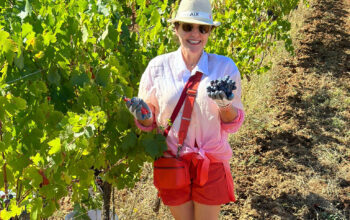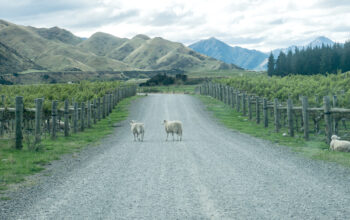Behind every bottle of wine are months of work and countless manual interventions. From pruning to harvesting, from pressing the grapes to serving their wines in the Hot or Buschenschank (wine pubs): we follow the wine growers closely. Full of passion, they take up the challenge: making the best wine from Austria! - TEXT EDITORS | IMAGE AUSTRIAN WINE / ROBERT HERBST
Living with the vines | Episode 1: spring
The winter hibernation of the vineyard is over. At the end of March, the vines' vegetative period begins. Their roots become active, they absorb water from the soil and they start 'bleeding'. This is what it is called when their sap starts oozing from the cuts in the fruit arms.

Tending the vineyard in March and April
Ideally, this is the time for the Austrian vintner to tie up the branches. This is because when the juice is flowing, it is easier to bend them and attach them to the wire without them break. There are all kinds of techniques for this important job and it ensures even budding and good distribution of shoots. This is also the time to make any necessary improvements or repairs to the wire slats and posts.
What you sow, you will reap!
In spring in Austria, vines that have died off are also replaced and new vineyards are planted. Budding begins in April. Buds break open and the green tops of shoots appear. Vintners now fear late night frosts, which could damage the young and sensitive leaves. They apply various methods to protect their vineyards from it.
Actions against night frost: from candles to helicopters
If the temperature drops only slightly below freezing, they set fire to straw bales in the vineyard, a technique that can keep late night frosts at bay. The smoke should prevent heat loss during the night and ensures that shoots warm up quickly when the sun rises. Another way to keep plants frost-free is to sprinkle the sensitive parts with water, which releases heat when frozen. Using helicopters to heat up the cold and warmer air or lighting candles in the vineyard can also help.
Composting
Vintners start tilling the soil in spring. Hoeing, loosening, and perhaps sowing some greening mix between the rows of vines. If necessary, fertiliser is used to nourish the soil. Nature-friendliness is the magic word in Austria, so in greening rows, grasses and herbs are simply left where they fell after mowing, which both protects the soil and adds nutrients.
Bottling the wine


Of course, there is plenty of work to do in the cellar in spring, such as bottling the wine. The Klassik lines, Gebietsweine (regional wines) and other fresh, fruity wines are bottled, labelled and prepared for sale. At this time of year, winemakers nurture their business relationships by participating in trade fairs and industry events.
Tending the vineyard in May and June
In the growing period, 'leaf management' becomes increasingly important. The grapevine puts a lot of energy into its growth, and if a vintner is not careful, all the energy goes into growing long shoots with leaves and not into ripening the grapes. Plant density is ensured by cutting off those long shoots and also the bolder double shoots and shoots lower on the stem, in German this is called Ausbrechen.
There follows another phase of intensive 'canopy management' in June, which is also carried out by hand. The leaves around the grapes are then thinned slightly to create optimal light and air conditions for the fresh fruit.
The blossom appears!
Blossom appears on the vines in Austria towards the end of May, although of course this depends on the climate and the grape variety. The ideal conditions for blossom are warm, dry weather. By the end of June, the flowers are already gone. Adverse weather conditions at this stage can lead to coulure, poor fruit setting or berry dropping.
Want to know more about the different growth stages? Read all at AUSTRIANWINE.COM and/or watch the fantastic videos from 'A year in the life of a winegrower' via YOUTUBE
Don't want to miss a single edition? Subscribe then subscribe to WINELIFE Magazine now!
Want to stay up to date with the best articles? Follow WINELIFE magazine on Instagram, Facebook and sign up for our fortnightly newsletter.




